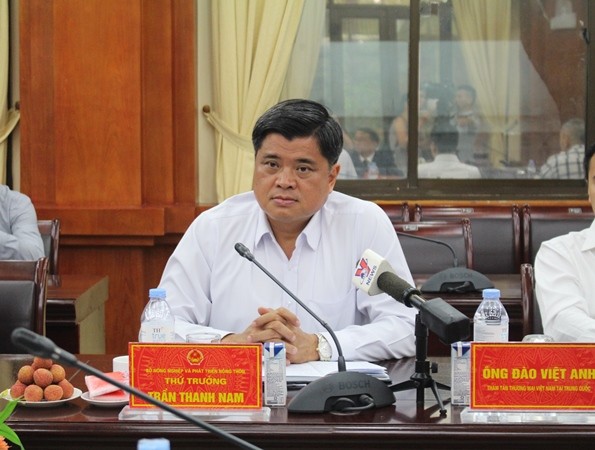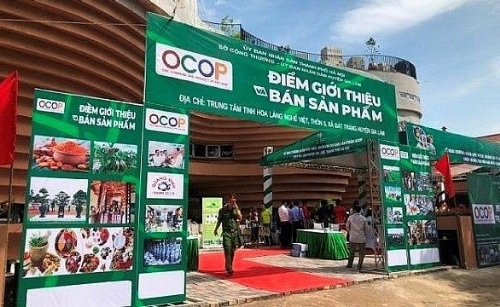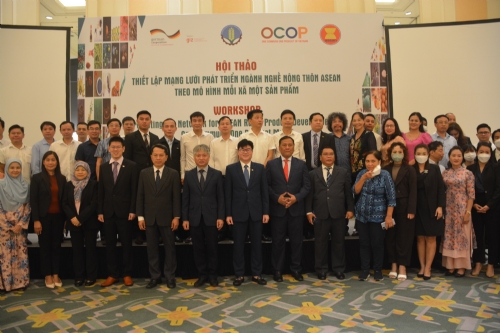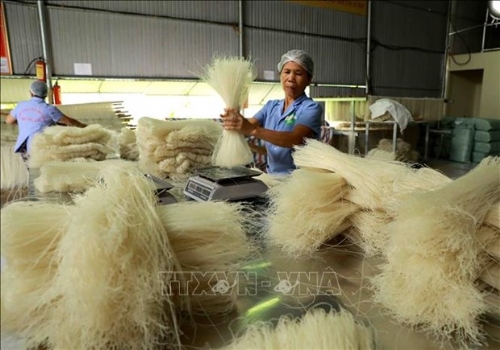Agricultural Restructuring from Perspective of OCOP Program
Saturday, January 25, 2020 10:37

The implementation of the One Commune One Product (OCOP) Program is of great significance to socioeconomic development. It has helped increase incomes, jobs, material and spiritual life for people, replace backward production practices, direct people toward the market economy, and create a new direction for the manufacture and trade of locally advantageous traditional products. Vietnam Business Forum Magazine’s correspondent has an interview with Mr. Tran Thanh Nam, Deputy Minister of Agriculture and Rural Development, on this topic. Do Ngoc reports.
It is already five years since agricultural restructuring was launched but it has not resulted in significant changes. What do you think about this?
Agricultural restructuring has achieved initial results. In general, the agricultural sector has revealed very vulnerable stages such as weak connectivity, weak processing capacity, and limited trade promotion in domestic and foreign markets. These weaknesses must be focally addressed by Vietnam’s agricultural sector in 2020 and further in subsequent years. If this works, agriculture will be sustainable and bring the highest value to farmers and stakeholders in the value chain.

Generally, Vietnam's agricultural production still depends too much on nature and weather. The quality of agricultural products is not high or consistent, and added value is low due to the low share of processed products. Agricultural products cannot play a dominant role on the market. Could you please describe some solutions to address these issues for the agricultural sector?
To address above limitations, the Government introduced many incentives to encourage investment in agriculture. As a result, at present, 6,010 businesses, cooperatives, and households (registered) are involved in agriculture. Particularly, 3,126 companies (accounting for 76.6% of agricultural production companies nationwide) produced 4,823 advantageous products categorized into six groups: Food, beverages, herbs, fabrics - garments, souvenirs - interiors - decorations, and rural service - tourism. Agricultural enterprises and cooperatives all apply high technology, thus reducing their dependence on nature and weather, ensure product quality, food hygiene and safety, and meet domestic and export market requirements. Fruit and vegetable processing facilities not only increase added value of agricultural products but also help regulate the market.
Given currently spontaneous agriculture, is it difficult to regulate the market?
To overcome spontaneous production, authorities must actively control production. For example, given the fact that pork prices have recently risen too high, the Ministry of Agriculture and Rural Development actively invited the 10 largest pork producers in the country to work with it and asked them to coordinate with authorities to protect the domestic market by proactively lowering pork prices. If the pork price is too high, the profit from pig farming will be very, very attractive, pig farming will mushroom and imported pork will flood into the market. Then, the pork price will drop sharply, livestock companies suffer losses and more dangerously, they will lose the domestic market.
Or, pangasius is gaining in price. Farmers in many Mekong Delta provinces spontaneously expand farming areas. Facing this reality, the Ministry of Agriculture and Rural Development sent two official dispatches and many missions to localities to urge strict control of pangasius farming, aiming to rear the catfish in about 5,200 ha and harvest about 1.3 million tons, although the market can absorb more than that. Agricultural restructuring is not only about increasing output but also about deepening cultivation, improving seeding/breeding quality, processing and diversifying post-harvest products to not only meet the export market but also meet the domestic market with more than 93 million consumers.
The OCOP Program has created breakthroughs in rural economy and helped agricultural restructuring. What should be done in the future to achieve program goals?
The OCOP Program gives priority to developing cooperatives and small and medium-sized enterprises (SMEs) to make advantageous, competitive traditional products and services for domestic and international markets and develop the rural economy by boosting internal force and increasing added value. Therefore, the program has helped economic restructuring, improved incomes and living standards for people and effectively carried out “Economics and production organization” criteria group in the set of national criteria for new-style rural communes. By 2020, at least 50% of existing products will be standardized; production cooperation model between households and enterprises will be consolidated and perfected; 8-10 cultural tourism village models will be launched; all companies and cooperatives joining the OCOP Program will be strengthened; about 500 new SMEs and cooperatives will join the OCOP Program; OCOP trade promotion and marketing programs will be sped up.
Beside opportunities and advantages, rural areas still face numerous challenges. For example, the rural population in Vietnam accounts for 68% of the country’s population; the rural labor force accounts for 65% of the country's labor force, the rich-poor gap is wide between rural and urban areas and climate change is hard to control. Therefore, the government is directing the task of inclusive agriculture, farmers and rural development, with the focus placed on the effective implementation of the National Target Program on New Countryside Construction. Many major projects and programs have been carried out by the Government, including the science and technology program for new countryside construction, the project on rural environmental treatment; support program for extremely poor communes, particularly the OCOP Program. This is defined as an important rural economic development program in the coming time.
Thank you very much!

 THE PROGRAM COOPERATED WITH CENTRAL COORDINATION FOR NEW-STYLE RURAL DEVELOPMENT
THE PROGRAM COOPERATED WITH CENTRAL COORDINATION FOR NEW-STYLE RURAL DEVELOPMENT
Other news
- HANOI: Promoting the consumption of craft village products and developing community tourism(11/5/2022 3:16:04 PM)
- Chuong My: Effectiveness from the One Commune One Product Program(11/3/2022 10:04:10 AM)
- Thanh Hoa develops OCOP products(11/1/2022 1:30:31 PM)
- Promoting the network for Asia Rural Product Development on one commune one product(8/30/2022 9:43:23 AM)
- Phu Tho eyes 56 new 3-star OCOP products for 2022(8/23/2022 3:09:56 PM)
- Opening of the OCOP product introduction week in Hanoi in 2022 in Phuc Tho district(8/1/2022 3:28:38 PM)
- Evaluation and classification of OCOP products Hoan Kiem District in 2022(7/27/2022 10:10:23 AM)
- Hanoi turns to green, sustainable agricultural sector(6/28/2022 4:10:22 PM)
- OCOP Forum in the Mekong Delta - Dong Thap 2022: Opening up great opportunities for regional products.(5/4/2022 2:38:13 PM)
- Over 1,000 spice products on display in Ho Chi Minh City(4/29/2022 2:34:02 PM)
The featured news
-
HANOI: Promoting the consumption of craft village products and developing community tourism
-
Promoting the network for Asia Rural Product Development on one commune one product
-
Phu Tho eyes 56 new 3-star OCOP products for 2022
-
Opening of the OCOP product introduction week in Hanoi in 2022 in Phuc Tho district
-
Evaluation and classification of OCOP products Hoan Kiem District in 2022






